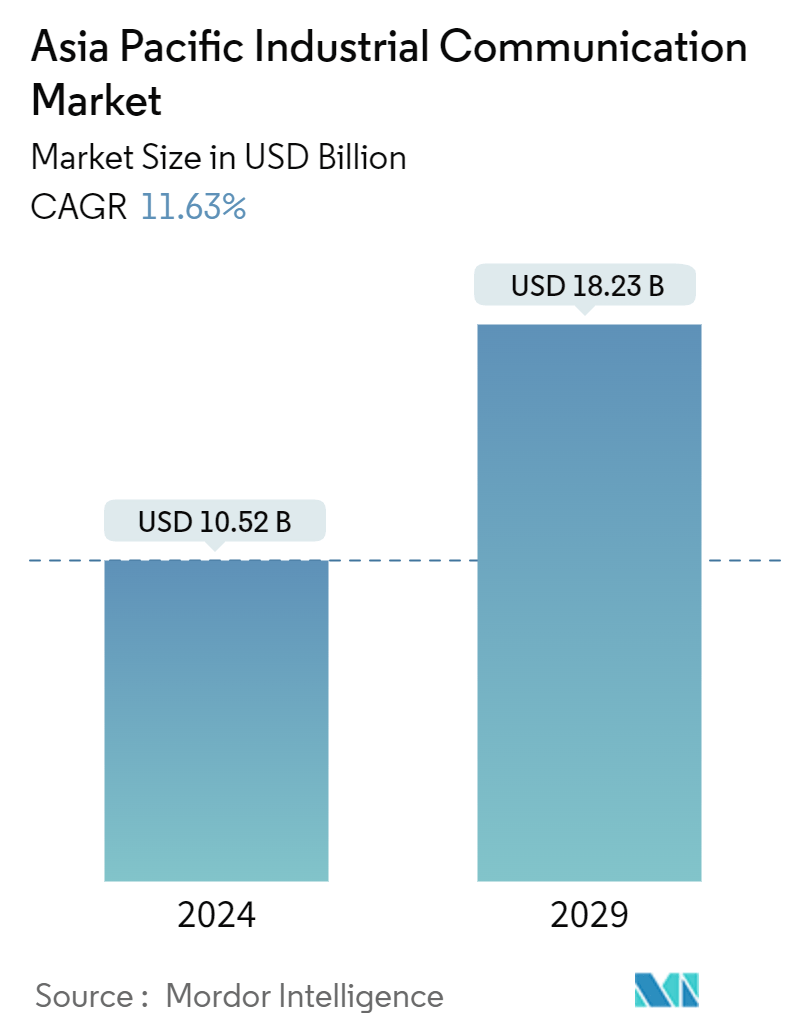Market Size of Asia-Pacific Industrial Communication Industry

| Study Period | 2019 - 2029 |
| Base Year For Estimation | 2023 |
| Market Size (2024) | USD 10.52 Billion |
| Market Size (2029) | USD 18.23 Billion |
| CAGR (2024 - 2029) | 11.63 % |
| Market Concentration | Low |
Major Players
*Disclaimer: Major Players sorted in no particular order |
Asia-Pacific Industrial Communication Market Analysis
The Asia Pacific Industrial Communication Market size is estimated at USD 10.52 billion in 2024, and is expected to reach USD 18.23 billion by 2029, growing at a CAGR of 11.63% during the forecast period (2024-2029).
- Asia-Pacific is among the fastest-growing industrial markets globally. Over the years, the footprint of the industrial sector has expanded significantly, driven by a favorable government outlook and the availability of an affordable workforce.
- For instance, China has established itself as the global manufacturing hub in the last few decades. A similar trend has been observed across other countries such as India, Taiwan, South Korea, and Indonesia. Hence, the growing industrial sector will remain among the major growth drivers for the studied market during the forecast period.
- Furthermore, the Asia-Pacific region is also among the leading power consumers. As a result, the region is witnessing a notable surge in investments in power grid infrastructure upgrades and oil & gas production activities. Automation is increasingly being used across these industries to enhance overall operational efficiency and to streamline the process of these industries. As a result, the expanding footprint of oil & gas and electricity utility industries is expected to create favorable growth opportunities in the studied market during the forecast period.
- However, installing an industrial communication system is cost-intensive as it requires companies to upgrade the infrastructure, incorporate modern end devices such as industrial sensors, and deploy supporting data transfer infrastructure such as LAN, WAN, etc. Considering the prominence of the MSME sector, which has limited financial capabilities, a higher adoption cost will remain among the major restraining factors for the growth of the market.
- The gradual upliftment of travel restrictions and lockdown measures helped the demand for industrial production grow considerably, helping the sector recover from the shock of the pandemic. The forecast period also appears promising for the sector as the region's economy is anticipated to continue its upward growth trajectory during the forecast period, thereby creating a favorable growth outlook for the market.
Asia-Pacific Industrial Communication Industry Segmentation
Industrial communication is a process through which data is transmitted from the field to the control level. A primary objective of these systems is to connect all facility sections in a single networked system, ensuring seamless data exchange and control in automated industrial systems. Industrial communication networks are widely regarded as the core of driving smart manufacturing scenarios.
The Asia-Pacific industrial communication market is segmented by component (hardware and software and services), communication type (wired, wireless, and analysis of wireless industrial communication by technology and frequency), end-user industry (automotive, oil and gas, utility sector, food and beverage, aerospace and defense, metal and mining, and other end-user industries), and country (China, India, Japan, South Korea, Malaysia, Singapore, Thailand, Taiwan, Australia, and Indonesia). The report offers market forecasts and size in value (USD) for all the above segments.
| By Component | |
| Hardware | |
| Software and Services |
| By Communication Type | |
| Wired | |
| Wireless | |
| Analysis of Wireless Industrial Communication by Technology and Frequency |
| By End User Industry | |
| Automotive | |
| Oil and Gas | |
| Utility Sector | |
| Food and Beverage | |
| Aerospace and Defense | |
| Metal and Mining | |
| Other End-user Industries |
| By Country*** | |
| China | |
| India | |
| Japan | |
| South Korea | |
| Malaysia | |
| Singapore | |
| Thailand | |
| Taiwan | |
| Australia | |
| Indonesia |
Asia-Pacific Industrial Communication Market Size Summary
The Asia-Pacific industrial communication market is poised for significant growth, driven by the region's robust industrial sector expansion and increasing adoption of automation technologies. The market is characterized by a favorable government outlook and the availability of a cost-effective workforce, which has bolstered the industrial sector's footprint across countries like China, India, Taiwan, South Korea, and Indonesia. The region's status as a leading power consumer has led to substantial investments in upgrading power grid infrastructure and enhancing oil and gas production activities. These developments are fostering the integration of automation to improve operational efficiency, thereby creating lucrative opportunities for industrial communication systems. However, the high cost of implementing these systems, particularly for micro, small, and medium enterprises (MSMEs), poses a challenge to market growth.
The automotive industry in Asia-Pacific, particularly in China, India, Japan, and South Korea, is a significant contributor to the market's expansion. The sector's high adoption rate of industrial automation and robotics solutions is expected to drive demand for industrial communication systems, which are essential for supporting these advanced technologies. China's position as a global manufacturing hub, coupled with its leading role in electric vehicle production, further underscores the market's growth potential. The presence of major players like Advantech Co. Ltd, Sick AG, Moxa Inc., ABB Limited, and Schneider Electric SE, who are actively engaging in strategic partnerships and expansions, highlights the competitive landscape of the market. These companies are continuously innovating and expanding their operations to meet the growing demand for industrial communication solutions in the region.
Asia-Pacific Industrial Communication Market Size - Table of Contents
-
1. MARKET INSIGHTS
-
1.1 Market Overview
-
1.2 Industry Attractiveness - Porter's Five Forces Analysis
-
1.2.1 Bargaining Power of Suppliers
-
1.2.2 Bargaining Power of Buyers
-
1.2.3 Threat of New Entrants
-
1.2.4 Threat of Substitute Products
-
1.2.5 Intensity of Competitive Rivalry
-
-
1.3 Industry Value Chain Analysis
-
-
2. MARKET SEGMENTATION
-
2.1 By Component
-
2.1.1 Hardware
-
2.1.2 Software and Services
-
-
2.2 By Communication Type
-
2.2.1 Wired
-
2.2.2 Wireless
-
2.2.3 Analysis of Wireless Industrial Communication by Technology and Frequency
-
-
2.3 By End User Industry
-
2.3.1 Automotive
-
2.3.2 Oil and Gas
-
2.3.3 Utility Sector
-
2.3.4 Food and Beverage
-
2.3.5 Aerospace and Defense
-
2.3.6 Metal and Mining
-
2.3.7 Other End-user Industries
-
-
2.4 By Country***
-
2.4.1 China
-
2.4.2 India
-
2.4.3 Japan
-
2.4.4 South Korea
-
2.4.5 Malaysia
-
2.4.6 Singapore
-
2.4.7 Thailand
-
2.4.8 Taiwan
-
2.4.9 Australia
-
2.4.10 Indonesia
-
-
2.5 UTILITY COMMUNICATION – MARKET OVERVIEW
-
2.6 POWER-LINE COMMUNICATION – MARKET OVERVIEW
-
2.7 TELEPROTECTION MARKET – MARKET OVERVIEW
-
Asia-Pacific Industrial Communication Market Size FAQs
How big is the Asia-Pacific Industrial Communication Market?
The Asia-Pacific Industrial Communication Market size is expected to reach USD 10.52 billion in 2024 and grow at a CAGR of 11.63% to reach USD 18.23 billion by 2029.
What is the current Asia-Pacific Industrial Communication Market size?
In 2024, the Asia-Pacific Industrial Communication Market size is expected to reach USD 10.52 billion.

